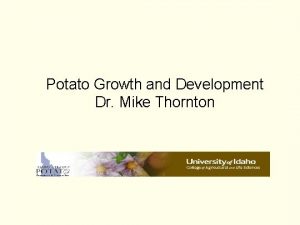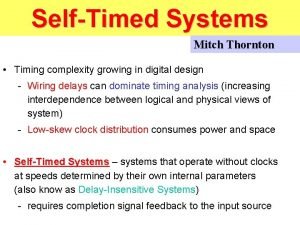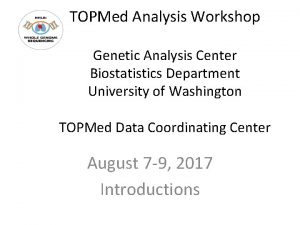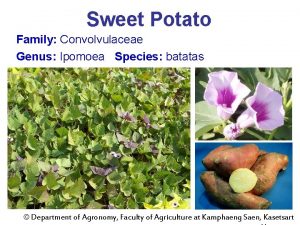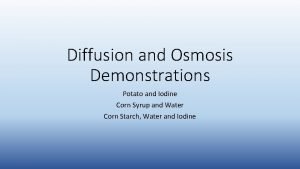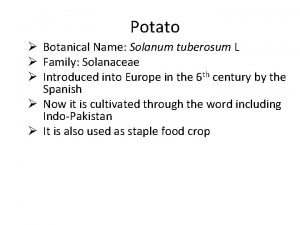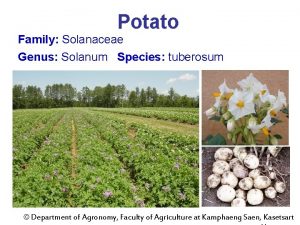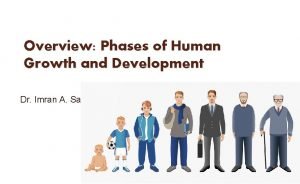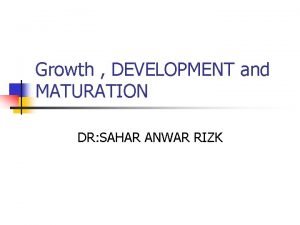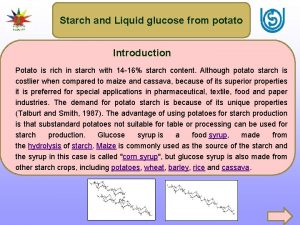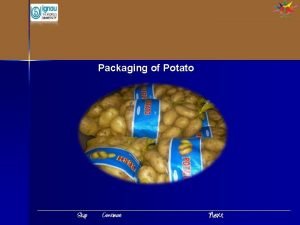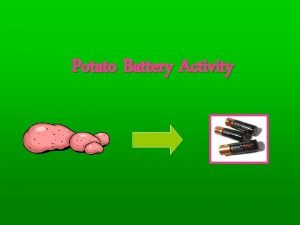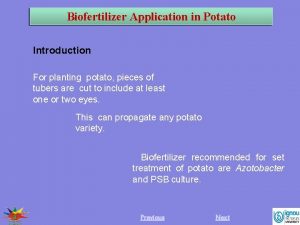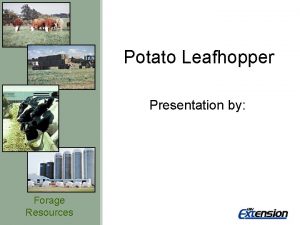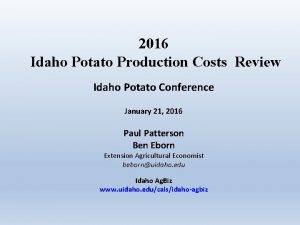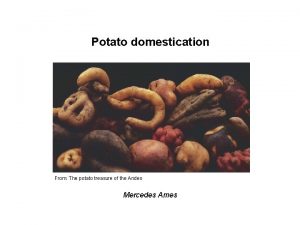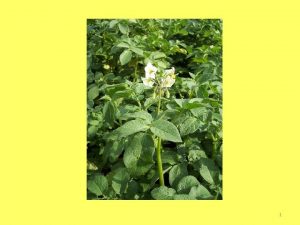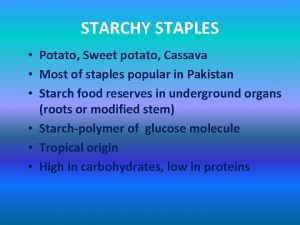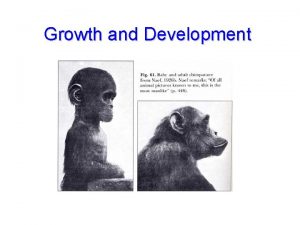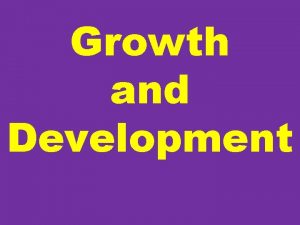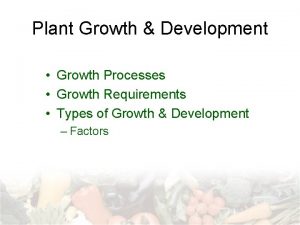Potato Growth and Development Dr Mike Thornton Outline









































- Slides: 41

Potato Growth and Development Dr. Mike Thornton

Outline Ø Ø Ø Growth stages Plant structures (leaves, roots, tubers) Management

Potato Growth Stages Reprinted from Potato Production Systems, University of ID

Plant growth types Indeterminate – Continues to produce leaves after bulking starts (late maturity) Determinate– Leaf production stops after bulking starts (early maturity)

l The potato plant is basically a starch factory Over 90% of tuber dry matter comes from photosynthesis

Components of the potato “factory” Evaporative Cooling CO 2 Leaves Roots Water/Nutrients Leaves Tubers Sugar

Photosynthesis - only in leaves Sugar – a form of stored energy

From Dean, 1994


Plants compensate for hail damage by being more productive in the remaining leaves

Young leaves Old leaves From Rowe, 1993

Components of the potato “factory” Evaporative Cooling CO 2 Leaves Roots Water/Nutrients Leaves Tubers Sugar

What do we know about potato root systems? 1 Ft 2 Ft 3 Ft 4 Ft Modified from Weaver (1926) Photo by M. Stalham, CUF

Potato roots pose some challenges Proportion that is root hairs 60% Total Root Length (km m-2) 30% 21% Adapted from: Stalham and Allen, 2001 and Yamaguchi, 2003

Rooting characteristics by maturity class Maturity group* Mean growth period (days) Root dry wt (g/plant) Very early 76 1. 3 Early 85 1. 6 Medium early 95 1. 8 Medium late 106 1. 9 Late 115 2. 2 Very late 134 2. 8 * Population of 268 unselected clones Source: Iwama, et al. , 1981

Cultivar differences in rooting depth 1 ft 2 ft 3 ft Source: Stalham, 2002

Components of the potato “factory” Evaporative Cooling CO 2 Leaves Roots Water/Nutrients Leaves Tubers Sugar


Why do so many defects show up on the stem end? - Stolon (vascular system) - Composition (cell size, no of starch granules, sugars, enzymes) - Age

üPlant Characteristics ü Vegetative propagation from tubers - True seed used in breeding

Sprouting

l The potato plant is basically a starch factory Over 90% of tuber dry matter comes from photosynthesis

How do we make the factory more productive? Build it faster!

Sprout growth rate is directly related to soil temperature Source: Kelmke and Moll, 1990

For the first ~40 days the seed piece is the primary source of energy for the factory Source: Iritani and Thornton, 1984

Slow emerging crops have shorter stems and smaller leaves Source: Firman, 1987

How do we make the factory more productive? Run it longer!

Yield Components Production per day Yield = Example 1: 10 cwt/day X 50 days = 500 cwt Example 2: 10 cwt/day X 70 days = 700 cwt 6 -10 cwt/day is typical for ID X Number of days

Effect on location on bulking rate cwt/A Parma Aberdeen DAP Location Length of Linear Bulking Rate of Linear Bulking Period (days) Rate (cwt/A/day) Parma 118 5. 9 Aberdeen 51 7. 4

Effect of N fertilizer on ground cover of Russet Burbank Ground cover (%) 100 N 200 80 60 40 20 0 1 -May 1 -Jun We need to maximize the period of 100%1 -Aug light 1 -Sep 1 -Jul capture 1 -Oct 1 -Nov

n Relatively poor use efficiency of other nutrients Species External K requirement (u. M conc. )* Internal K requirement (% K in dry matter) Potato 40. 5 7. 7 Wheat 6. 4 5. 8 Sugar beet 4. 4 5. 4 * For 90% maximum dry matter accumulation Source: Trehan and Claassen, 1998

Potato Root Growth in Comparison to Nutrient Uptake (Russet Burbank) Source: Pan, 1994

You can’t run the factory at full capacity without intercepting sunlight

How do we make the factory more productive? Run it more efficiently!

The factory has several critical processes l The temperature optimum for Photosynthesis (energy production) is around 75 o to 80 o F , Respiration (energy use) continues to increase with temperature Source: Winkler, 1961

Carbohydrate production is the critical process Fewer carbs available to drive tuber growth Day Night cool warm hot warm hot

Once the factory is running, sunny but cool (70 to 80 F) conditions help make it more efficient Cool temperatures during bulking help the factory run efficiently Source: Iritani, 1984

l What about “silver bullet” products that claim to improve yield and quality?

Any product that is going to increase yield has to: - Build the factory quicker! OR - Run the factory longer! OR - Run it more efficiently!

Control of yield and quality is complicated Environmen t Genetic Potential Managemen t

Key Points ü ü Potatoes undergo five stages of development Leaves, roots and tubers are all key components of the potato “factory” Light interception (photosynthesis) is the key process that drives productivity Canopy development/duration and length of tuber bulking determine final yield
 What are the stages of potato growth
What are the stages of potato growth Corporate family tree
Corporate family tree Mitch thornton
Mitch thornton Prashan patel
Prashan patel Oakburn ward lynfield mount
Oakburn ward lynfield mount Greg thornton history
Greg thornton history Edmedcare
Edmedcare Tim thornton uw
Tim thornton uw Grant thornton
Grant thornton Thornton center rome ga
Thornton center rome ga Katherine thornton statement
Katherine thornton statement Big mama thornton biography
Big mama thornton biography Define growth analysis
Define growth analysis Shoot system
Shoot system Primary growth and secondary growth in plants
Primary growth and secondary growth in plants Primary growth and secondary growth in plants
Primary growth and secondary growth in plants Quotation sandwich example
Quotation sandwich example Carothers equation
Carothers equation Geometric growth population
Geometric growth population Neoclassical growth theory vs. endogenous growth theory
Neoclassical growth theory vs. endogenous growth theory Difference between organic and inorganic growth
Difference between organic and inorganic growth Social statuses
Social statuses Sweet potato genus
Sweet potato genus Potato and iodine diffusion experiment
Potato and iodine diffusion experiment Potato botanical name family
Potato botanical name family Catechol oxidase and potato extract lab report
Catechol oxidase and potato extract lab report Plural for tomato
Plural for tomato Potato genus and species
Potato genus and species Mangoes is countable or uncountable
Mangoes is countable or uncountable Stages of human growth and development pictures
Stages of human growth and development pictures Different theories of growth and development
Different theories of growth and development Stages of human growth and development pictures
Stages of human growth and development pictures Stages of human growth and development pictures
Stages of human growth and development pictures Pretest growth development and sexuality
Pretest growth development and sexuality Growth development maturation
Growth development maturation Pattern of growth and development
Pattern of growth and development Social development in late childhood
Social development in late childhood Conclusion of growth and development
Conclusion of growth and development Domain 7 personal growth and development
Domain 7 personal growth and development Growth and development pictures
Growth and development pictures Middle childhood growth and development
Middle childhood growth and development Distinguish between growth and development
Distinguish between growth and development
